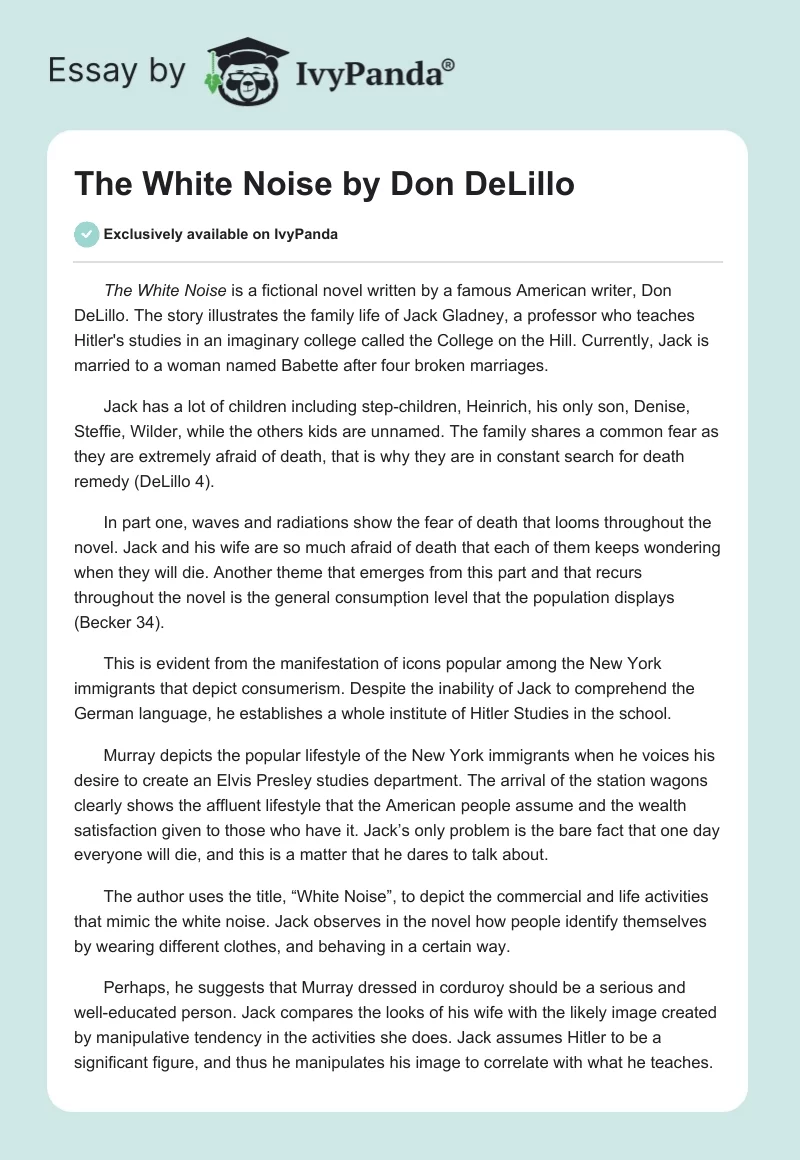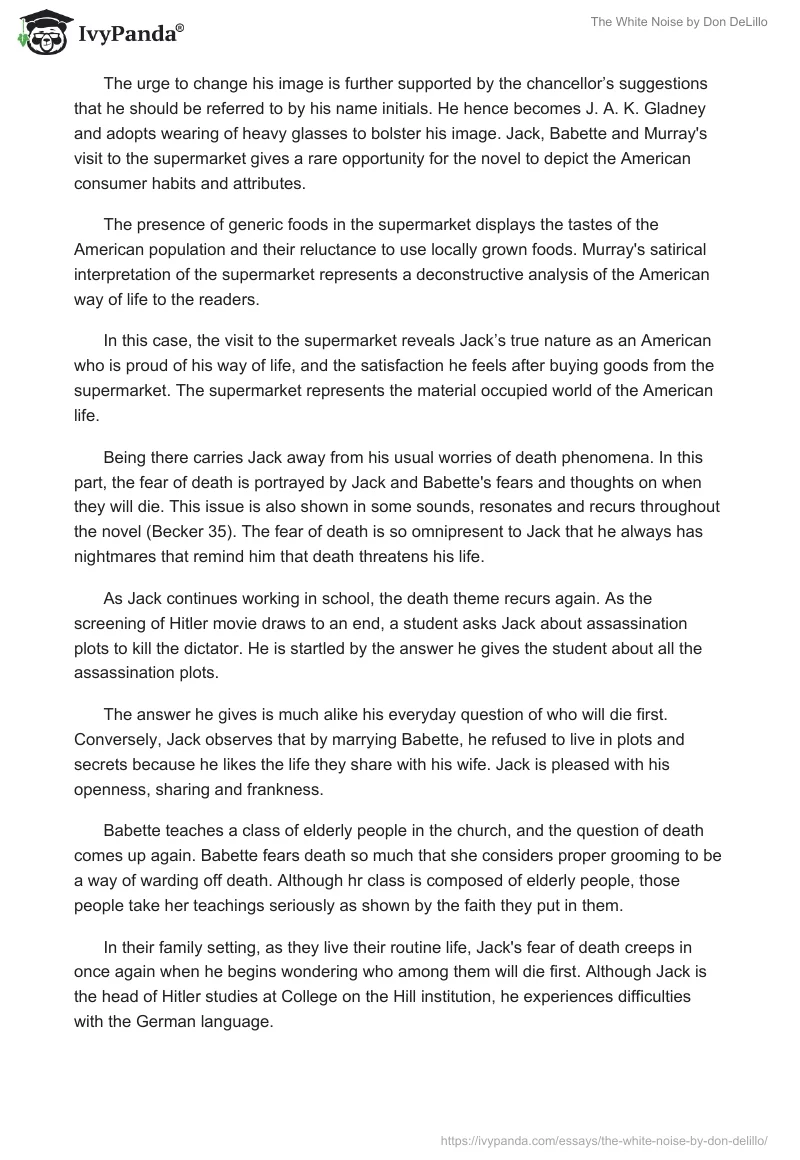The White Noise is a fictional novel written by a famous American writer, Don DeLillo. The story illustrates the family life of Jack Gladney, a professor who teaches Hitler’s studies in an imaginary college called the College on the Hill. Currently, Jack is married to a woman named Babette after four broken marriages.
Jack has a lot of children including step-children, Heinrich, his only son, Denise, Steffie, Wilder, while the others kids are unnamed. The family shares a common fear as they are extremely afraid of death, that is why they are in constant search for death remedy (DeLillo 4).
In part one, waves and radiations show the fear of death that looms throughout the novel. Jack and his wife are so much afraid of death that each of them keeps wondering when they will die. Another theme that emerges from this part and that recurs throughout the novel is the general consumption level that the population displays (Becker 34).
This is evident from the manifestation of icons popular among the New York immigrants that depict consumerism. Despite the inability of Jack to comprehend the German language, he establishes a whole institute of Hitler Studies in the school.
Murray depicts the popular lifestyle of the New York immigrants when he voices his desire to create an Elvis Presley studies department. The arrival of the station wagons clearly shows the affluent lifestyle that the American people assume and the wealth satisfaction given to those who have it. Jack’s only problem is the bare fact that one day everyone will die, and this is a matter that he dares to talk about.
The author uses the title, “White Noise”, to depict the commercial and life activities that mimic the white noise. Jack observes in the novel how people identify themselves by wearing different clothes, and behaving in a certain way.
Perhaps, he suggests that Murray dressed in corduroy should be a serious and well-educated person. Jack compares the looks of his wife with the likely image created by manipulative tendency in the activities she does. Jack assumes Hitler to be a significant figure, and thus he manipulates his image to correlate with what he teaches.
The urge to change his image is further supported by the chancellor’s suggestions that he should be referred to by his name initials. He hence becomes J. A. K. Gladney and adopts wearing of heavy glasses to bolster his image. Jack, Babette and Murray’s visit to the supermarket gives a rare opportunity for the novel to depict the American consumer habits and attributes.
The presence of generic foods in the supermarket displays the tastes of the American population and their reluctance to use locally grown foods. Murray’s satirical interpretation of the supermarket represents a deconstructive analysis of the American way of life to the readers.
In this case, the visit to the supermarket reveals Jack’s true nature as an American who is proud of his way of life, and the satisfaction he feels after buying goods from the supermarket. The supermarket represents the material occupied world of the American life.
Being there carries Jack away from his usual worries of death phenomena. In this part, the fear of death is portrayed by Jack and Babette’s fears and thoughts on when they will die. This issue is also shown in some sounds, resonates and recurs throughout the novel (Becker 35). The fear of death is so omnipresent to Jack that he always has nightmares that remind him that death threatens his life.
As Jack continues working in school, the death theme recurs again. As the screening of Hitler movie draws to an end, a student asks Jack about assassination plots to kill the dictator. He is startled by the answer he gives the student about all the assassination plots.
The answer he gives is much alike his everyday question of who will die first. Conversely, Jack observes that by marrying Babette, he refused to live in plots and secrets because he likes the life they share with his wife. Jack is pleased with his openness, sharing and frankness.
Babette teaches a class of elderly people in the church, and the question of death comes up again. Babette fears death so much that she considers proper grooming to be a way of warding off death. Although hr class is composed of elderly people, those people take her teachings seriously as shown by the faith they put in them.
In their family setting, as they live their routine life, Jack’s fear of death creeps in once again when he begins wondering who among them will die first. Although Jack is the head of Hitler studies at College on the Hill institution, he experiences difficulties with the German language.
Since his college is hosting a Hitler conference, he cannot fail to learn the language (DeLillo 4). The dislike for the German language and the alien views of his German teacher confer to the reader the outsider’s perspective that the American citizens have on other citizens.
Jack’s homestead depicts turmoil. Everyone in the homestead is busy with his own activities that they barely notice Murray and Jack entering. It is evident that according to Jack’s world-views, all the plots lead to death, and therefore, there is a high likelihood that his fear of planning the life might have made him divorce his former wives.
The novel is wary of creating a plot. Jack wonders about the development of baldness on his son’s head. His concerns about the presence of toxins in the environment and the danger that looms in his son’s life give a notion of events to come. His worries also represent his deep love for his son and the novel’s humanitarian condition.
The situation turns ugly in part three. Jack’s fear of poisons in the environment is founded when people start exhibiting peculiar symptoms for unknown conditions (DeLillo 5).
The schools close down for tests to be conducted. Jack’s fear of death seems to have a breakthrough when the menace surrounding the schools comes to an end without major incidences, except for the rumors on the demise of Myles-suited inspector.
Jack’s fear of Heinrich safety is confirmed when Heinrich and Tommy Roy Foster form a relationship that lands the latter in prison. The omnipresence of danger looms as Tommy appears in the life of Heinrich. As they discuss and compare Hitler and Tommy, Heinrich compares his father to a mass murderer and a figure which he uses to develop his identity.
This is presented when Jack attempts a murder. This incident proves that Jack is as voracious as Hitler was. The part also displays coding evident in the way people perceive and analyze events and activities around them (Richardson 21). The explosion that sends a cloud of smoke up the sky hits the city and keeps Jack vague ideas alive.
According to DeLillo’s assertions, the toxins released in the environment prove that everything is poisoned and confirm the death threat that haunts Jack throughout the novel (p.5).
The explosion also serves to differentiate the reality and mind creations as presented in Jack’s constant fear of death. After SIMUVAC prognosis, Jack feels and views himself as a man who is destined to die after the explosion. His hunt for relaxation seems fraught, touching and juvenile. His observations about the large metropolis also reflect his growing logic of segregation.
We all must die on our own, and Jack begin to accept that knowledge. He starts a secret venture to find a drug named Daylar which he thinks will prevent him from dying. His family’s fear of death drives Babette to cheat on her husband in order to obtain the drug, which, as she insists, will alleviate the condition she has.
Babette explains that that drug can help her overcome her fear of death. Stephie is involved in a SIMUVAC show when Jack decides to go for the second check, but he is afraid that he may look for a placebo. The infidelity of Babette brings back the fear of death and plot inherent throughout the novel.
The novel ends with Jack’s plot to assassinate Mink and steal his Dylar. The plot to kill Mink fails as it is foiled. As they both seek medical help, the nurse explains to Jack that illusions and mind creations are necessary.
The nurse further states that false faith has a purpose. In the hospital bed, Jack finds that learning German is comforting as it heightens the feelings that can be a solution of the difficult situation at some point (Berman 128). However, death still remains inevitable, and not even Daylar can save from it.
Although the novel is fictional, it has opened the doors for other fictional writers to use plot-less method to depict certain dominant themes in their work. DeLillo became a pioneer in depicting American lifestyle and the inherent danger it draws on its citizens.
Throughout the novel, DeLillo employs hidden meanings to draw attention of later writers and warn the Americans of the dangerous lifestyle they lead.
The fear of death in the novel may be compared to the current growth of anti-American sentimental feelings and the constant threat the country faces. Besides, various satires, means and figures of speech are used by the author to set stage and eventually lay grounds for the development of the current American literature.
Works Cited
Becker, Ernest. The Denial of Death, New York: Free Press, 1973. Print.
Berman, Morris. The Re-enchantment of the World, New York: Bantam, 1984:128-29. Print.
DeLillo, Don. White Noise, New York: Penguin Books, 1986. Print.
Hawthorne, Nathaniel. The Gray Champion. Introduction to Great American Short Stories: From Hawthorne to Hemingway. New York, NY: Barnes and Noble, 2009. Print.
Irving, Washington. The Legend of Sleepy Hollow, New York, NY: Tor Classics 1991. Print.
Myers, Andrew. A Century of Commentary on the Works of Washington Irving, Tarrytown: Sleepy Hollow Restorations, 1976. Print.
Pochmann, Henry. “Irving’s German Sources in the Sketch Book,” Studies in Philology 27 (1930): 47707. Print.
Richardson, Judith. Possessions: The History and Uses of Haunting in the Hudson Valley, Cambridge, Mass: Harvard University Press, 2003. Print.
Ringe, Donald. American Gothic: Imagination and Reason in Nineteenth-Century Fiction, Lexington: University Press of Kentucky, 1982. Print.
Rubin-Dorsky, Jeffrey. Adrift in the Old World: The Psychological Pilgrimage of Washington Irving, Chicago: University of Chicago Press, 1988. Print.
Serres, Michel. “The Origin of Language: Biology, Information Theory, and Thermodynamics.” In Hermes: Literature, Science, Philosophy, Baltimore: Johns Hopkins University Press, 1982. Print.
Wilden, Anthony. System and Structure. London: Tavistock, 1980. Print.


